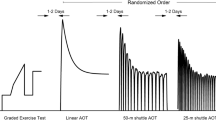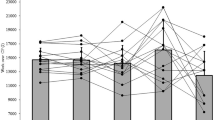Abstract
Purpose
Acceleration and deceleration phases characterise shuttle running (SR) compared to constant speed running (CR); mechanical work is thus expected to be larger in the former compared to the latter, at the same average speed (v mean). The aim of this study was to measure total mechanical work (W +tot , J kg−1 m−1) during SR as the sum of internal (W +int ) and external (W +ext ) work and to calculate the efficiency of SR.
Methods
Twenty males were requested to perform shuttle runs over a distance of 5 + 5 m at different speeds (slow, moderate and fast) to record kinematic data. Metabolic data were also recorded (at fast speed only) to calculate energy cost (C, J kg−1 m−1) and mechanical efficiency (eff+ = W +tot C −1) of SR.
Results
Work parameters significantly increased with speed (P < 0.001): W +ext = 1.388 + 0.337 v mean; W +int = −1.002 + 0.853 v mean; W +tot = 1.329 v mean. At the fastest speed C was 27.4 ± 2.6 J kg−1 m−1 (i.e. about 7 times larger than in CR) and eff+ was 16.2 ± 2.0 %.
Conclusions
W +ext is larger in SR than in CR (2.5 vs. 1.4 J kg−1 m−1 in the range of investigated speeds: 2–3.5 m s−1) and W +int , at fast speed, is about half of W +tot . eff+ is lower in SR (16 %) than in CR (50–60 % at comparable speeds) and this can be attributed to a lower elastic energy reutilization due to the acceleration/deceleration phases over this short shuttle distance.




Similar content being viewed by others
Abbreviations
- SR:
-
Shuttle running
- CR:
-
Constant speed running
- CoD:
-
Change of direction
- BCoM:
-
Body centre of mass
- E P :
-
Gravitational potential energy of BCoM
- E K :
-
Kinetic energy of BCoM
- d :
-
Shuttle distance
- v mean :
-
Mean shuttle speed
- v max :
-
Maximal shuttle speed
- W ext :
-
External mechanical work per unit mass and distance
- W int :
-
Internal mechanical work per unit mass and distance
- W tot :
-
Total mechanical work per unit mass and distance
- t ex :
-
Exercise time
- t tot :
-
Total exercise duration
- C netSR :
-
Net energy cost of shuttle running
- C netCR :
-
Net energy cost of constant speed running
- eff+ :
-
Mechanical efficiency
References
Abdelkrim NB, El Fazaa S, El Ati J (2007) Time-motion analysis and physiological data of elite under-19-year-old basketball players during competition. Br J Sports Med 41(2):69–75
Abdelkrim NB, Castagna C, Jabri I, Battikh T, El Fazaa S, El Ati J (2010) Activity profile and physiological requirements of junior basketball players in relation to aerobic-anaerobic fitness. J Strength Cond Res 24(9):2330–2342
Ahn AN, Furrow E, Biewener AA (2004) Walking and running in the red-legged running frog, Kassina maculata. J Exp Biol 207:399–410
Aleshinsky SY (1986) An energy ‘sources’ and ‘fractions’ approach to the mechanical energy expenditure problem. V. The mechanical energy expenditure reduction during motion of the multi-link system. J Biomech 19:311–315
Biewener AA (2006) Patterns of mechanical energy change in tetrapod gait: pendula, spring and work. J Exp Zool 305A:899–911
Buchheit M, Bishop D, Haydar B, Nakamura FY, Ahmaidi S (2010) Physiological responses to shuttle repeated-sprint running. Int J Sports Med 31:402–409
Buglione A, di Prampero PE (2013) The energy cost of shuttle running. Eur J Appl Physiol 113:1535–1543
Cavagna GA, Kaneko M (1977) Mechanical work and efficiency in level walking and running. J Physiol 268:467–481
Cavagna GA, Komarek L, Mazzoleni S (1971) The mechanics of sprint running. J Physiol 217:709–721
di Prampero PE, Ferretti G (1999) The energetics of anaerobic muscle metabolism: a reappraisal of older and recent concepts. Resp Physiol 188:103–115
Impellizzeri FM, Rampinini E, Castagna C, Bishop D, Bravo DF, Tibaudi A, Wisloff U (2008) Validity of a repeated-sprint test for football. Int J Sports Med 29(11):899–905
Makaje N, Ruangthai R, Arkarapanthu A, Yoopat P (2012) Physiological demands and activity profiles during futsal match play according to competitive level. J Sports Med Phys Fitness 52(4):366–374
Margaria R, Oliva RD, di Prampero PE, Cerretelli P (1969) Energy utilization in intermittent exercise at supramaximal speeds. J Appl Physiol 26:752–756
Minetti AE, Ardigò LP, Saibene F (1993) Mechanical determinants of gradient walking energetics in man. J Physiol 472:725–735 [Erratum in: J Physiol (1994) 475:548]
Minetti AE, Gaudino P, Seminati E, Cazzola D (2013) The cost of transport of human running is not affected, as in walking, by wide acceleration/deceleration cycles. J Appl Physiol 114:498–503
Rubenson J, Heliams DB, Lloyd DG, Fournier PA (2004) Gait selection in the ostrich: mechanical and metabolic characteristics of walking and running with and without an aerial phase. Proc Biol Sci 271:1091–1099
Saibene F, Minetti AE (2003) Biomechanical and physiological aspects of legged locomotion in humans. Eur J Appl Physiol 88:297–316
Stevens TG, De Ruiter CG, Van Maurik D, Van Lierop CJ, Savelsbergh GJ, Beek PJ (2015) Measured and estimated energy cost of constant and shuttle running in soccer players. Med Sci Sport Exerc 47:1219–1224
Willems PA, Cavagna GA, Heglund NC (1995) External, internal and total work in human locomotion. J Exp Biol 198:379–393
Winter DA (2005) Biomechanics and motor control of human movement, 3rd edn. Wiley, New York, pp 1–369
Wooledge RC, Curtin NA, Homsher E (1985) Energetic aspects of muscle contraction. Monogr Physiol Soc 41:1–357
Zadro I, Sepulcri L, Lazzer S, Fregolent R, Zamparo P (2011) A protocol of intermittent exercise (shuttle runs) to train young basketball players. J Strength Cond Res 25:1767–1773
Zamparo P, Zadro I, Lazzer S, Beato M, Sepulcri L (2014) Energetics of shuttle runs: the effects of distance and change of direction. Int J Sport Physiol Perf 9:1033–1039
Zamparo P, Bolomini F, Nardello F, Beato M (2015) Energetics (and kinematics) of short shuttle runs. Eur J Appl Physiol 115:1985–1994
Acknowledgments
We would like to thank Davide Giacopuzzi, Gianluigi Ghia e Lorenzo Manca for their help in data collection.
Author information
Authors and Affiliations
Corresponding author
Ethics declarations
Conflict of interest
The authors report no conflict of interest.
Additional information
Communicated by Jean-René Lacour.
Appendix
Appendix
In any form of locomotion, the metabolic request to achieve a given speed can be fully understood if all components of the mechanical work are investigated.
In shuttle running, differently from constant linear running, braking can be substantial, thus the analysis of mechanical work performed by muscles to move BCoM (W ext) and limbs (W int) have to consider both positive and negative work in order to better estimate the metabolic demand. As a general rule, the metabolic cost of locomotion can be calculated as:
where + and − indicate positive and negative values. On the level, positive (W +) and negative (W −) work are by definition the same (whereas positive and negative power could be different because of a possible different duration of the positive and negative work phases). When this is the case, a multiple linear regression is unable to estimate different positive (eff+) and negative (eff−) values of efficiency.
It thus could be convenient to rearrange this equation by imposing W + = W − and a constrained ratio between eff+ and eff− (e.g. 1:5) compatibly with previously reported data from muscle physiology (Wooledge et al. 1985) and reasonable for all activation levels. Accordingly, Eq. 3 turns into:
When considering individual data of W +ext , W +int and C measured in this study at maximal speed, eff +ext = 12.7 % and eff +int = 65.1 %; conversely, when considering individual values of W +ext and W +int measured in this study and a previous metabolic estimate at the same speed (C = −12.82 + 11.94 v mean, Zamparo et al. 2015), the multiple regression analysis resulted in eff +ext = 23.5 % (IC 95 % 20.8–27.0 %) and eff +int = 18.9 % (IC 95 % 16.2–22.7 %) R 2 = 0.982, P < 0.001. The apparent inconsistency in the obtained values of efficiencies by using these two methods and the fact that some of these estimates are far out of the physiological range can be explained by the limits data impose to statistics. Since the measured W +ext and W +int values are very similar when taken at the highest speeds only, this makes the regression unable to infer reliable estimates of eff +ext and eff +int . Formally, it corresponds to moving from (z = a · x + b · y) to (z = a · x + b · x), where x and y stand for W +ext and W +int , respectively, and a and b stand for 1/eff +ext and 1/eff +int respectively. The second equation (z = a · x + b · x) is equivalent to (z = c · x) with (c = a + b); however, infinite pairs of a and b values can produce the same value of c. Due to this uncertainty, a further assumption could be made: i.e. that eff +ext = eff +int = eff +tot ; in this case Eq. 4 can be simplified as:
Equation 5 corresponds to turning (z = a · x + b · y) into (z = c (x + y)) where c (1/eff +tot ) is the sum of a (1/eff +ext ) and b (1/eff +int ). Being a and b reciprocal values of the unknown parameters, if c can be obtained as the arithmetic mean of a and b, eff +tot can be calculated as the harmonic mean of eff +ext and eff +int : 21.3 % (from eff +ext 12.7 and eff +int 65.1 %, maximal speed tests only) and 21.0 % (from eff +ext 23.5 and eff +int 18.9 %, whole tests including data from Zamparo et al. 2015). These total efficiency estimates comfortably sit within the physiological range and suggest that no elastic energy storage/release occurs in 5 + 5 m shuttle runs.
Since eff +ext and eff +int prove to be similar (e.g. 23.5 and 18.9 in the whole range of speeds), and considering that W +tot = W +ext + W +int , Eq. 5 can be further simplified as:
Equation 6 can be used to estimate the total efficiency for positive work, i.e.:
and we need to recollect that this estimate, though indicating just the total positive mechanical work, corrects the efficiency according to the presence of negative work (the 6/5 coefficient). But this is still a prediction at a given level of exercise and all the previous provided figures for efficiency dealt with the mean values across all shuttle run speeds. When studying this activity at different speeds, efficiency values are shown to decrease from 24.0 %, at 2.0 m s−1, to 16.1 %, at 3.5 m s−1, (28.8 %, at 2.0 m s−1, to 19.3 %, at 3.5 m s−1 when the 6/5 coefficient is introduced) as shown in Fig. 4, which can also be expressed formally as
by considering that W +tot = 1.329 v mean (see “Results”) and C = −12.82 + 11.94 v mean (from Zamparo et al. 2015). As reported in the “Discussion”, the decrease of efficiency can be partially explained by the increase of muscle contraction speed, as a consequence of the Hill force/speed relationship.
Rights and permissions
About this article
Cite this article
Zamparo, P., Pavei, G., Nardello, F. et al. Mechanical work and efficiency of 5 + 5 m shuttle running. Eur J Appl Physiol 116, 1911–1919 (2016). https://doi.org/10.1007/s00421-016-3443-6
Received:
Accepted:
Published:
Issue Date:
DOI: https://doi.org/10.1007/s00421-016-3443-6




